Jixiang Luo
SmartFreeEdit: Mask-Free Spatial-Aware Image Editing with Complex Instruction Understanding
Apr 17, 2025

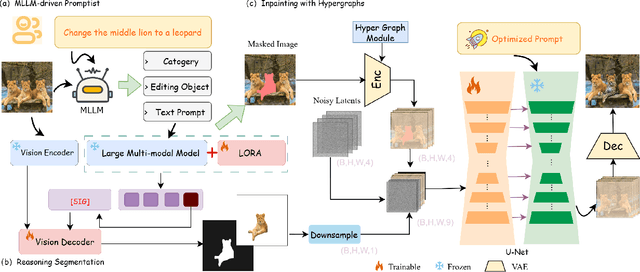
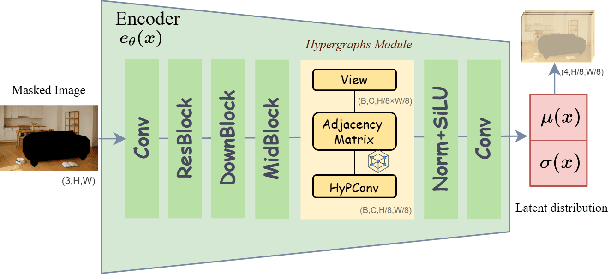
Abstract:Recent advancements in image editing have utilized large-scale multimodal models to enable intuitive, natural instruction-driven interactions. However, conventional methods still face significant challenges, particularly in spatial reasoning, precise region segmentation, and maintaining semantic consistency, especially in complex scenes. To overcome these challenges, we introduce SmartFreeEdit, a novel end-to-end framework that integrates a multimodal large language model (MLLM) with a hypergraph-enhanced inpainting architecture, enabling precise, mask-free image editing guided exclusively by natural language instructions. The key innovations of SmartFreeEdit include:(1)the introduction of region aware tokens and a mask embedding paradigm that enhance the spatial understanding of complex scenes;(2) a reasoning segmentation pipeline designed to optimize the generation of editing masks based on natural language instructions;and (3) a hypergraph-augmented inpainting module that ensures the preservation of both structural integrity and semantic coherence during complex edits, overcoming the limitations of local-based image generation. Extensive experiments on the Reason-Edit benchmark demonstrate that SmartFreeEdit surpasses current state-of-the-art methods across multiple evaluation metrics, including segmentation accuracy, instruction adherence, and visual quality preservation, while addressing the issue of local information focus and improving global consistency in the edited image. Our project will be available at https://github.com/smileformylove/SmartFreeEdit.
Rethinking Learned Image Compression: Context is All You Need
Jul 16, 2024Abstract:Since LIC has made rapid progress recently compared to traditional methods, this paper attempts to discuss the question about 'Where is the boundary of Learned Image Compression(LIC)?' with regard to subjective matrics. Thus this paper splits the above problem into two sub-problems:1)Where is the boundary of rate-distortion performance of PSNR? 2)How to further improve the compression gain and achieve the boundary? Therefore this paper analyzes the effectiveness of scaling parameters for encoder, decoder and context model, which are the three components of LIC. Then we conclude that scaling for LIC is to scale for context model and decoder within LIC. Extensive experiments demonstrate that overfitting can actually serve as an effective context. By optimizing the context, this paper further improves PSNR and achieves state-of-the-art performance, showing a performance gain of 14.39% with BD-RATE over VVC.
Compressible and Searchable: AI-native Multi-Modal Retrieval System with Learned Image Compression
Apr 16, 2024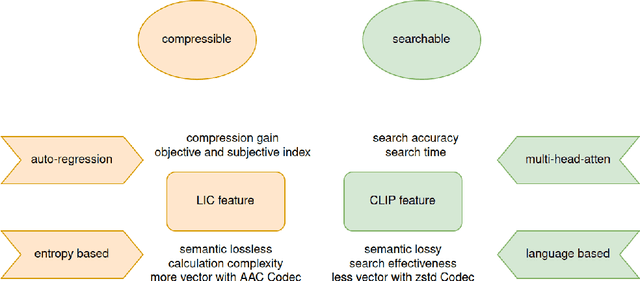



Abstract:The burgeoning volume of digital content across diverse modalities necessitates efficient storage and retrieval methods. Conventional approaches struggle to cope with the escalating complexity and scale of multimedia data. In this paper, we proposed framework addresses this challenge by fusing AI-native multi-modal search capabilities with neural image compression. First we analyze the intricate relationship between compressibility and searchability, recognizing the pivotal role each plays in the efficiency of storage and retrieval systems. Through the usage of simple adapter is to bridge the feature of Learned Image Compression(LIC) and Contrastive Language-Image Pretraining(CLIP) while retaining semantic fidelity and retrieval of multi-modal data. Experimental evaluations on Kodak datasets demonstrate the efficacy of our approach, showcasing significant enhancements in compression efficiency and search accuracy compared to existing methodologies. Our work marks a significant advancement towards scalable and efficient multi-modal search systems in the era of big data.
Task-Aware Encoder Control for Deep Video Compression
Apr 07, 2024



Abstract:Prior research on deep video compression (DVC) for machine tasks typically necessitates training a unique codec for each specific task, mandating a dedicated decoder per task. In contrast, traditional video codecs employ a flexible encoder controller, enabling the adaptation of a single codec to different tasks through mechanisms like mode prediction. Drawing inspiration from this, we introduce an innovative encoder controller for deep video compression for machines. This controller features a mode prediction and a Group of Pictures (GoP) selection module. Our approach centralizes control at the encoding stage, allowing for adaptable encoder adjustments across different tasks, such as detection and tracking, while maintaining compatibility with a standard pre-trained DVC decoder. Empirical evidence demonstrates that our method is applicable across multiple tasks with various existing pre-trained DVCs. Moreover, extensive experiments demonstrate that our method outperforms previous DVC by about 25% bitrate for different tasks, with only one pre-trained decoder.
Super-High-Fidelity Image Compression via Hierarchical-ROI and Adaptive Quantization
Mar 19, 2024



Abstract:Learned Image Compression (LIC) has achieved dramatic progress regarding objective and subjective metrics. MSE-based models aim to improve objective metrics while generative models are leveraged to improve visual quality measured by subjective metrics. However, they all suffer from blurring or deformation at low bit rates, especially at below $0.2bpp$. Besides, deformation on human faces and text is unacceptable for visual quality assessment, and the problem becomes more prominent on small faces and text. To solve this problem, we combine the advantage of MSE-based models and generative models by utilizing region of interest (ROI). We propose Hierarchical-ROI (H-ROI), to split images into several foreground regions and one background region to improve the reconstruction of regions containing faces, text, and complex textures. Further, we propose adaptive quantization by non-linear mapping within the channel dimension to constrain the bit rate while maintaining the visual quality. Exhaustive experiments demonstrate that our methods achieve better visual quality on small faces and text with lower bit rates, e.g., $0.7X$ bits of HiFiC and $0.5X$ bits of BPG.
Unified learning-based lossy and lossless JPEG recompression
Dec 05, 2023
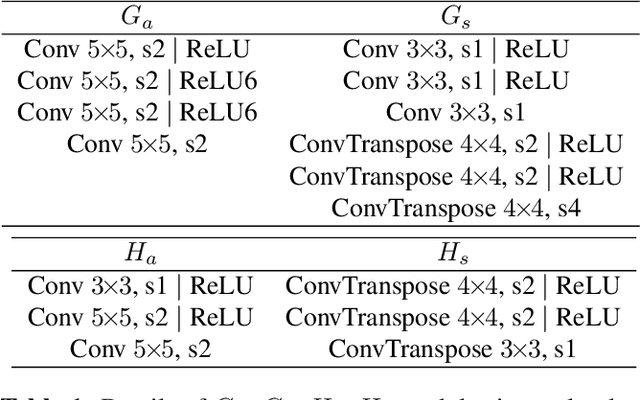
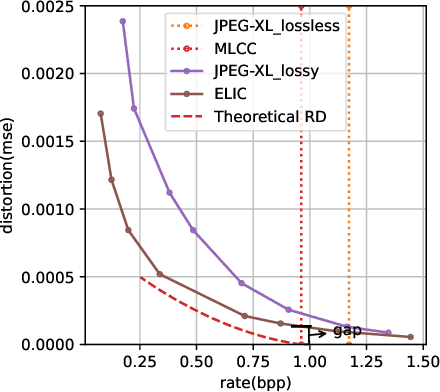
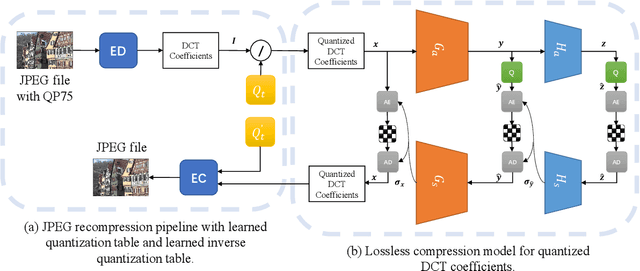
Abstract:JPEG is still the most widely used image compression algorithm. Most image compression algorithms only consider uncompressed original image, while ignoring a large number of already existing JPEG images. Recently, JPEG recompression approaches have been proposed to further reduce the size of JPEG files. However, those methods only consider JPEG lossless recompression, which is just a special case of the rate-distortion theorem. In this paper, we propose a unified lossly and lossless JPEG recompression framework, which consists of learned quantization table and Markovian hierarchical variational autoencoders. Experiments show that our method can achieve arbitrarily low distortion when the bitrate is close to the upper bound, namely the bitrate of the lossless compression model. To the best of our knowledge, this is the first learned method that bridges the gap between lossy and lossless recompression of JPEG images.
Efficient Learned Lossless JPEG Recompression
Aug 25, 2023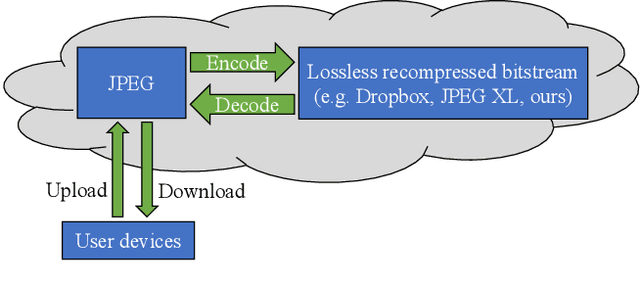
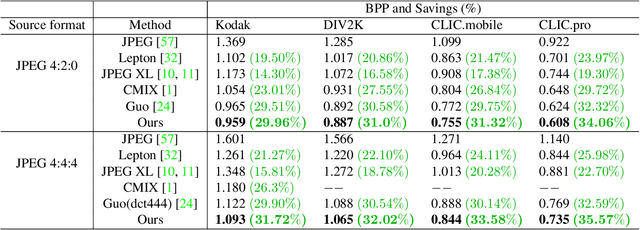
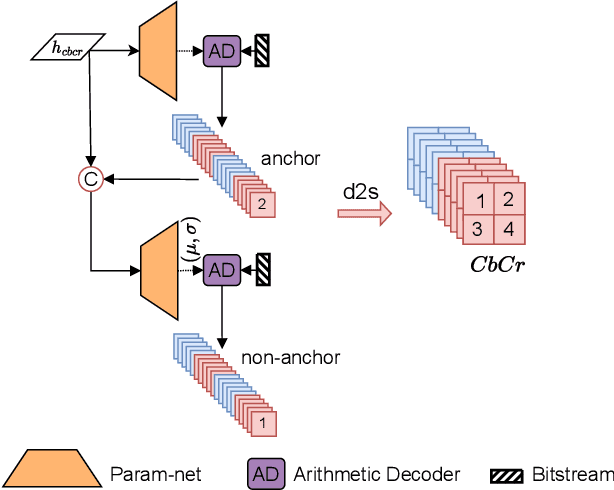

Abstract:JPEG is one of the most popular image compression methods. It is beneficial to compress those existing JPEG files without introducing additional distortion. In this paper, we propose a deep learning based method to further compress JPEG images losslessly. Specifically, we propose a Multi-Level Parallel Conditional Modeling (ML-PCM) architecture, which enables parallel decoding in different granularities. First, luma and chroma are processed independently to allow parallel coding. Second, we propose pipeline parallel context model (PPCM) and compressed checkerboard context model (CCCM) for the effective conditional modeling and efficient decoding within luma and chroma components. Our method has much lower latency while achieves better compression ratio compared with previous SOTA. After proper software optimization, we can obtain a good throughput of 57 FPS for 1080P images on NVIDIA T4 GPU. Furthermore, combined with quantization, our approach can also act as a lossy JPEG codec which has obvious advantage over SOTA lossy compression methods in high bit rate (bpp$>0.9$).
Learned Lossless Compression for JPEG via Frequency-Domain Prediction
Mar 05, 2023Abstract:JPEG images can be further compressed to enhance the storage and transmission of large-scale image datasets. Existing learned lossless compressors for RGB images cannot be well transferred to JPEG images due to the distinguishing distribution of DCT coefficients and raw pixels. In this paper, we propose a novel framework for learned lossless compression of JPEG images that achieves end-to-end optimized prediction of the distribution of decoded DCT coefficients. To enable learning in the frequency domain, DCT coefficients are partitioned into groups to utilize implicit local redundancy. An autoencoder-like architecture is designed based on the weight-shared blocks to realize entropy modeling of grouped DCT coefficients and independently compress the priors. We attempt to realize learned lossless compression of JPEG images in the frequency domain. Experimental results demonstrate that the proposed framework achieves superior or comparable performance in comparison to most recent lossless compressors with handcrafted context modeling for JPEG images.
Evaluating the Practicality of Learned Image Compression
Jul 29, 2022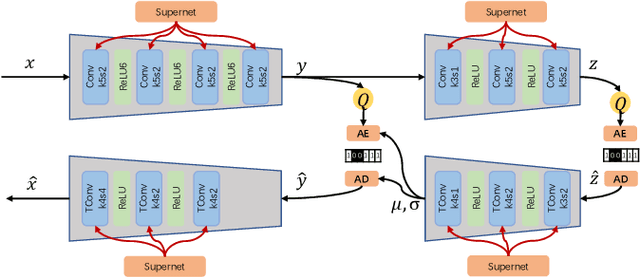
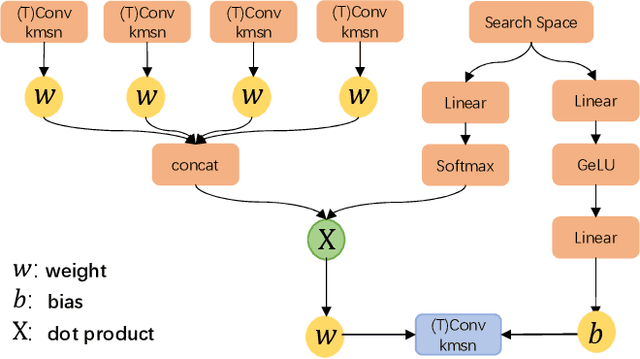
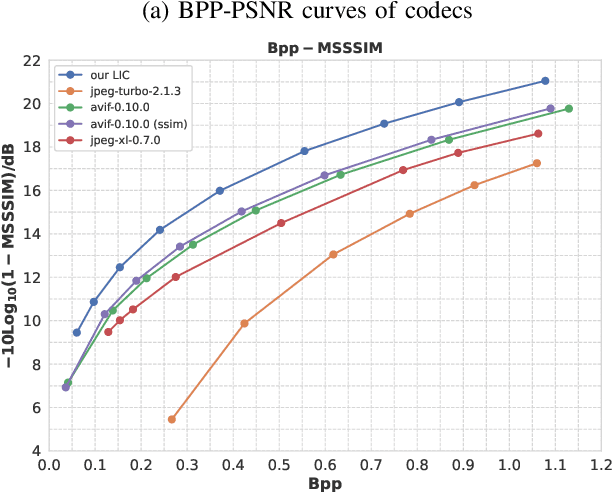
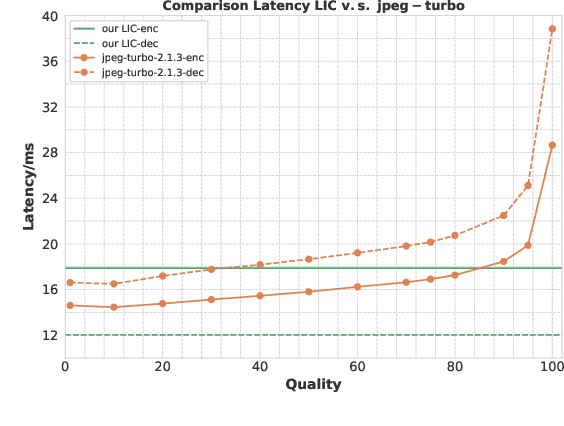
Abstract:Learned image compression has achieved extraordinary rate-distortion performance in PSNR and MS-SSIM compared to traditional methods. However, it suffers from intensive computation, which is intolerable for real-world applications and leads to its limited industrial application for now. In this paper, we introduce neural architecture search (NAS) to designing more efficient networks with lower latency, and leverage quantization to accelerate the inference process. Meanwhile, efforts in engineering like multi-threading and SIMD have been made to improve efficiency. Optimized using a hybrid loss of PSNR and MS-SSIM for better visual quality, we obtain much higher MS-SSIM than JPEG, JPEG XL and AVIF over all bit rates, and PSNR between that of JPEG XL and AVIF. Our software implementation of LIC achieves comparable or even faster inference speed compared to jpeg-turbo while being multiple times faster than JPEG XL and AVIF. Besides, our implementation of LIC reaches stunning throughput of 145 fps for encoding and 208 fps for decoding on a Tesla T4 GPU for 1080p images. On CPU, the latency of our implementation is comparable with JPEG XL.
PO-ELIC: Perception-Oriented Efficient Learned Image Coding
May 28, 2022

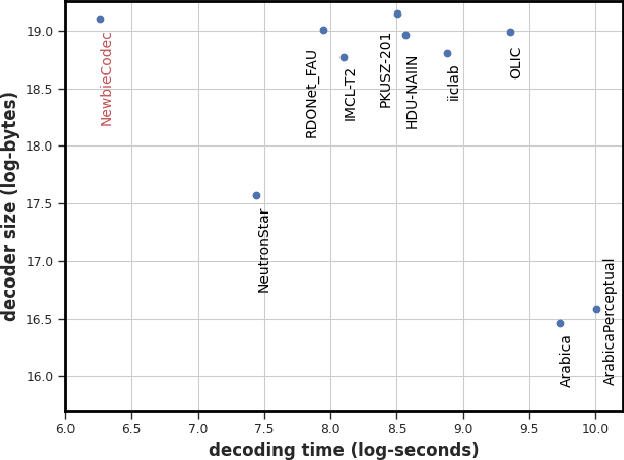
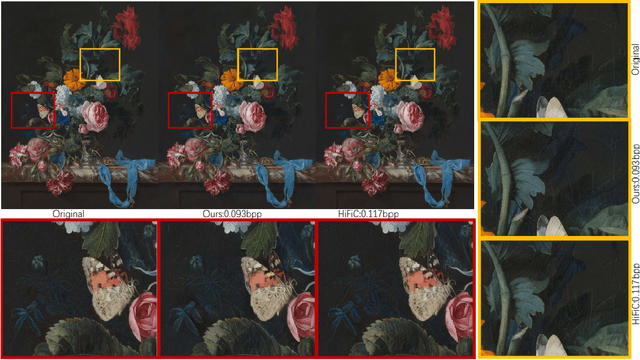
Abstract:In the past years, learned image compression (LIC) has achieved remarkable performance. The recent LIC methods outperform VVC in both PSNR and MS-SSIM. However, the low bit-rate reconstructions of LIC suffer from artifacts such as blurring, color drifting and texture missing. Moreover, those varied artifacts make image quality metrics correlate badly with human perceptual quality. In this paper, we propose PO-ELIC, i.e., Perception-Oriented Efficient Learned Image Coding. To be specific, we adapt ELIC, one of the state-of-the-art LIC models, with adversarial training techniques. We apply a mixture of losses including hinge-form adversarial loss, Charbonnier loss, and style loss, to finetune the model towards better perceptual quality. Experimental results demonstrate that our method achieves comparable perceptual quality with HiFiC with much lower bitrate.
 Add to Chrome
Add to Chrome Add to Firefox
Add to Firefox Add to Edge
Add to Edge